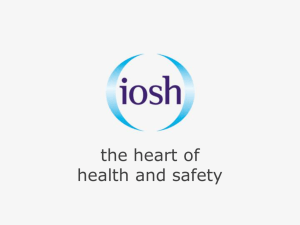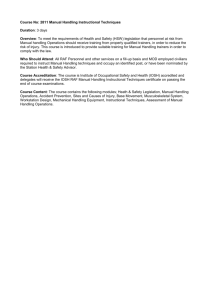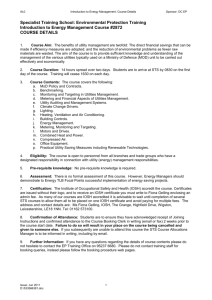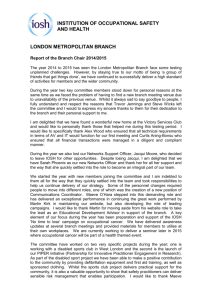Electrical Safety in a Modern Working Environment - July 2015
advertisement
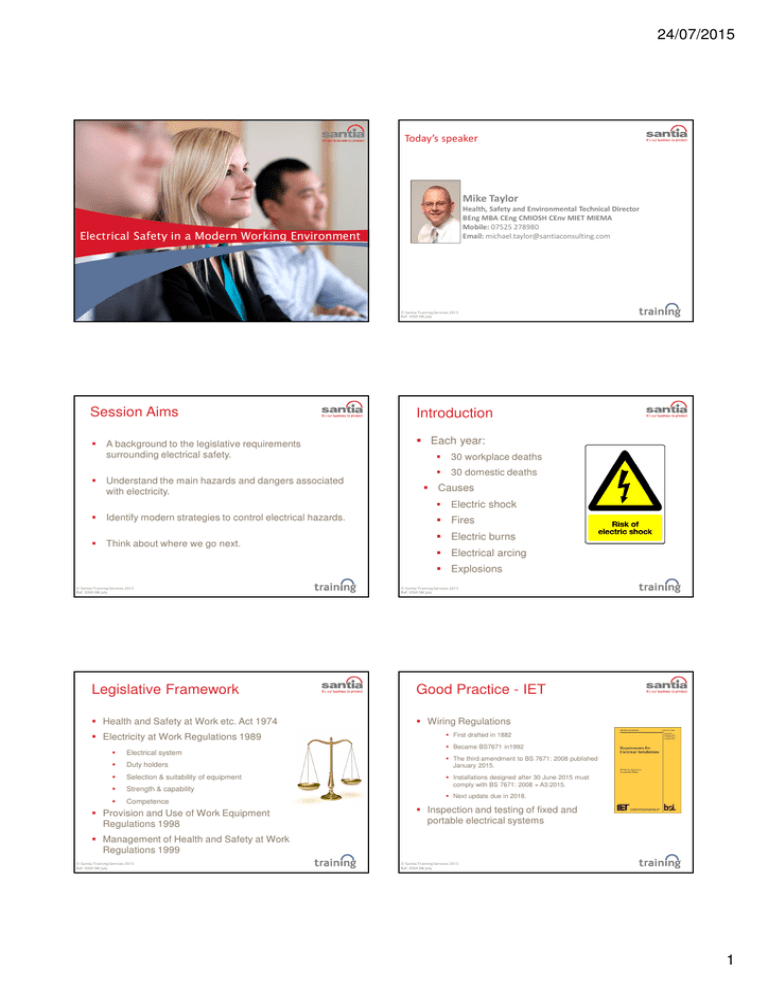
24/07/2015 Today’s speaker Mike Taylor Health, Safety and Environmental Technical Director BEng MBA CEng CMIOSH CEnv MIET MIEMA Mobile: 07525 278980 Email: michael.taylor@santiaconsulting.com Electrical Safety in a Modern Working Environment © Santia Training Services 2012 Sales Ref: xx/xxxx/vx Session Aims A background to the legislative requirements surrounding electrical safety. Understand the main hazards and dangers associated with electricity. Identify modern strategies to control electrical hazards. Think about where we go next. © Santia Training Services 2015 Ref: IOSH SW July Introduction Each year: 30 workplace deaths 30 domestic deaths Causes Electric shock Fires Electric burns Electrical arcing Explosions © Santia Training Services 2015 Ref: IOSH SW July © Santia Training Services 2015 Ref: IOSH SW July Legislative Framework Good Practice - IET Health and Safety at Work etc. Act 1974 Wiring Regulations Electricity at Work Regulations 1989 Electrical system Duty holders Selection & suitability of equipment Strength & capability Competence Provision and Use of Work Equipment Regulations 1998 First drafted in 1882 Became BS7671 in1992 The third amendment to BS 7671: 2008 published January 2015. Installations designed after 30 June 2015 must comply with BS 7671: 2008 + A3:2015. Next update due in 2018. Inspection and testing of fixed and portable electrical systems Management of Health and Safety at Work Regulations 1999 © Santia Training Services 2015 Ref: IOSH SW July © Santia Training Services 2015 Ref: IOSH SW July 1 24/07/2015 Principles of Electricity Ohms law Voltage, Current, Resistance Resistance Measured in Ohms (Ω) Electricity - The Hazards, Dangers and Controls Current flow will take the path of least resistance Conductors Copper, water, carbon, steel, etc. Current carrying capacity Insulators Rubber, plastic, air, etc. © Santia Training Services 2015 Ref: IOSH SW July © Santia Training Services 2015 Ref: IOSH SW July Electric Shock Health Effects Damage to the nervous system / pain Irregular heartbeat (fibrillation) Cardiac arrest Respiratory paralysis Severity of Electrical Shock Factors include: Voltage Current Time exposed - milliseconds (ms) Body and environment conductivity or resistance Burns – surface and internal Current path Muscular contractions Nature of contact Physical trauma (shock) Individual factors © Santia Training Services 2015 Ref: IOSH SW July © Santia Training Services 2015 Ref: IOSH SW July Effect of Electricity The Electrocution Principle AC current in milliamps (mA) Effects 0.5 to 2 Threshold of perception 2 to 10 Painful sensation 10 to 25 Inability to let go, danger of asphyxiation This is more than twice the amount of current required to cause a fatal injury. 25 to 80 Loss of consciousness from cardiac or respiratory failure Fatality would not normally be expected below 50V ac. Over 80 Burns at point of contact, death from fibrillation © Santia Training Services 2015 Ref: IOSH SW July A standard UK socket can provide up to 13A at 230V. The average human body’s resistance is around 2000 Ohms Using Ohms law we can see that: 230/2000 = 115mA © Santia Training Services 2015 Ref: IOSH SW July 2 24/07/2015 Installation, Use & Inspection of Electrical Systems EAWR 1989 Insulation, protection and placing of conductors Methods of Preventing Electric Shock MCB – Miniature Circuit Breakers Earthing or other suitable precautions: Designed for fusing of mains supplies. Can be selected for different currents. Can be selected for different loads. Double insulation – Class II Earthing & automatic disconnection – Class I Fuses Circuit breakers, MCBs Use of safe voltages 110 V CTE SELV Battery powered equipment © Santia Training Services 2015 Ref: IOSH SW July Methods of Preventing Electric Shock Type B = 3 to 5 times load current. Type C = 5 to 10 times load current. Type K = 8 to 12 times load current. Type D = 10 to 20 times load current. © Santia Training Services 2015 Ref: IOSH SW July RCD Circuit Diagram RCD – (Residual Current Device) Disconnects supply if an imbalance of 30mA or more is detected. Can be used for class 1 & 2 equipment. An crucial requirement for equipment where liquids are in use. May not detect overloads or shorts. Unless combined with an MCB © Santia Training Services 2015 Ref: IOSH SW July DC Power Sources – the Future? © Santia Training Services 2015 Ref: IOSH SW July Causes of Electrical Fires Inadequate circuits, e.g. 5A wire carrying 13A current Overloaded circuits Incorrect fuse Damaged insulation, etc. Loose connections Flammable materials too close to electrical equipment Overheating cables on coils No let go Excessive thermal insulation of cables More serious burn potential Lack of ventilation Often involve capacitors - High potential energy storage Unauthorised use, misuse, private equipment DC Power Sources Micro-generation Batteries or rectified AC Low voltage systems in buildings Cars Issues © Santia Training Services 2015 Ref: IOSH SW July © Santia Training Services 2015 Ref: IOSH SW July 3 24/07/2015 Electrical Burns Direct burns Electric current generates heat Internal and external burns Indirect burns Arcing The heat generated is often sufficient to start fires or cause injury. Arc Flash – Electrical Flashover External burns Short circuit melts a tool, e.g. screwdrivers Spray of molten metal and UV light © Santia Training Services 2015 Ref: IOSH SW July Work on or near Live Conductors – EAWR 14 Live working Sufficient potential to jump across an insulation material, usually air. More prominent? Risk Assessment Calculation – IEEE1584 © Santia Training Services 2015 Ref: IOSH SW July Live Working – Risk Assessment Elimination of the arc flash hazard. Unreasonable in all circumstances for it to be dead; Reasonable in all circumstances for it to be live; and Suitable precautions (including where necessary the provision of suitable protective equipment) are taken to prevent injury. Unsafe Working Practices Modifications whilst the equipment is “live” Correct isolation not carried out Understand arc flash, signage, competence. PPE © Santia Training Services 2015 Ref: IOSH SW July Procedures, authorisations, testing and maintenance. Information and training. Lower trip levels / settings, Design, UV Trips. Control the risk. De-energise, segregate, finger protection, condition. Reduction. Last resort, flameproof overalls, mush research. © Santia Training Services 2015 Ref: IOSH SW July Isolation – ‘Lock Off, Tag Out’ Working on systems made dead Planning the job Disconnection from power Isolation – secure e.g. locking off Unsuitable modifications Misuse Proving dead Unsuitable equipment Earthing as additionally precaution Notices Other precautions Communication of the SSoW Using ‘second hand’ components Use of damaged equipment Equipment out of test date (e.g. PAT) Not following the fault reporting process © Santia Training Services 2015 Ref: IOSH SW July Physical barriers, temporary insulation © Santia Training Services 2015 Ref: IOSH SW July 4 24/07/2015 Adverse or Hazardous Environments DSEAR 2002 Hazardous Area Classification Probability of the hazard Escape Zoning – Gas / Vapour or Dust Ignition Source Where to Now Electric apparatus; Stray electric currents; Static electricity; Lightning Ionizing radiation; Radio frequency etc. © Santia Training Services 2015 Ref: IOSH SW July © Santia Training Services 2015 Ref: IOSH SW July Electricity Supply Edison’s original vision was a direct current, locally based electricity system. Electricity Use Point of use versus mobile. Global information connections. Battery operated equipment. Demand Versus supply. Renewables, Fossil, Nuclear. Power electronics – Inverters etc. Transmission and distribution. Smart systems. Local generation and use. End of life. DC Versus AC Sustainability. © Santia Training Services 2015 Ref: IOSH SW July © Santia Training Services 2015 Ref: IOSH SW July Santia Training Services 5

